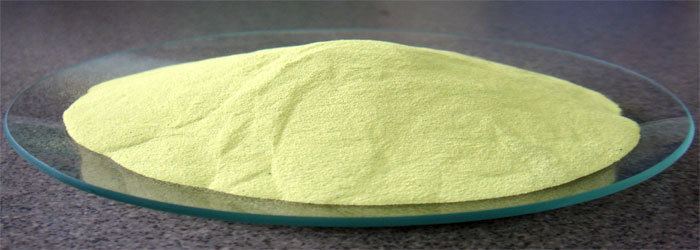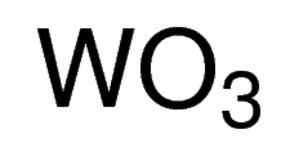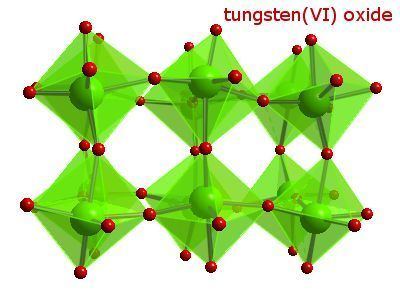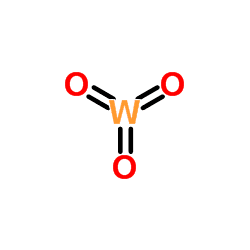Formula WO3 Molar mass 231.84 g/mol Appearance Canary yellow powder | Melting point 1,473 °C Density 7.16 g/cm³ | |
 | ||
Tungsten trioxide intercalation
Tungsten(VI) oxide, also known as tungsten trioxide or tungstic anhydride, WO3, is a chemical compound containing oxygen and the transition metal tungsten. It is obtained as an intermediate in the recovery of tungsten from its minerals. Tungsten ores are treated with alkalis to produce WO3. Further reaction with carbon or hydrogen gas reduces tungsten trioxide to the pure metal.
Contents


Tungsten(VI) oxide occurs naturally in the form of hydrates, which include minerals: tungstite WO3·H2O, meymacite WO3·2H2O and hydrotungstite (of the same composition as meymacite, however sometimes written as H2WO4). These minerals are rare to very rare secondary tungsten minerals.

History

Tungsten has a rich history dating back to its discovery during the 18th century. Peter Woulfe was the first to recognize a new element in the naturally occurring mineral wolframite. Tungsten was originally known as wolfram, explaining the choice of "W" for its elemental symbol. Swedish chemist Carl Wilhelm Scheele contributed to its discovery with his studies on the mineral scheelite.

In 1841, a chemist named Robert Oxland gave the first procedures for preparing tungsten trioxide and sodium tungstate. He was granted patents for his work soon after, and is considered to be the founder of systematic tungsten chemistry.
Preparation

Tungsten trioxide can be prepared in several different ways. CaWO4, or scheelite, is allowed to react with HCl to produce tungstic acid, which decomposes to WO3 and water at high temperatures.
CaWO4 + 2 HCl → CaCl2 + H2WO4H2WO4 → H2O + WO3Another common way to synthesize WO3 is by calcination of ammonium paratungstate (APT) under oxidizing conditions:
(NH4)10[H2W12O42]•4H2O → 12 WO3 + 10 NH3 + 10 H2OStructure
The crystal structure of tungsten trioxide is temperature dependent. It is tetragonal at temperatures above 740 °C, orthorhombic from 330 to 740 °C, monoclinic from 17 to 330 °C, and triclinic from -50 to 17 °C. The most common structure of WO3 is monoclinic with space group P21/n.
Uses
Tungsten trioxide is used for many purposes in everyday life. It is frequently used in industry to manufacture tungstates for x-ray screen phosphors, for fireproofing fabrics and in gas sensors. Due to its rich yellow color, WO3 is also used as a pigment in ceramics and paints.
In recent years, tungsten trioxide has been employed in the production of electrochromic windows, or smart windows. These windows are electrically switchable glass that change light transmission properties with an applied voltage. This allows the user to tint their windows, changing the amount of heat or light passing through.
2010- AIST reports a quantum yield of 19% in photocatalytic water splitting with a caesium-enhanced tungsten oxide photocatalyst.
In 2013, highly photocatalytic active titania/tungsten (VI) oxide/noble metal (Au and Pt) composites toward oxalic acid were obtained by the means of selective noble metal photodeposition on the desired oxide's surface (either on TiO2 or on WO3). The composite showed a modest hydrogen production performance.
In 2016, shape controlled tungsten trioxide semiconductors were obtained by the means of hydrothermal synthesis. From these semiconductors composite systems were prepared with commercial TiO2. These composite systems showed a higher photocatalysis activity then the commercial TiO2 (Evonik Aeroxide P25) towards phenol and methyl orange degradation.
